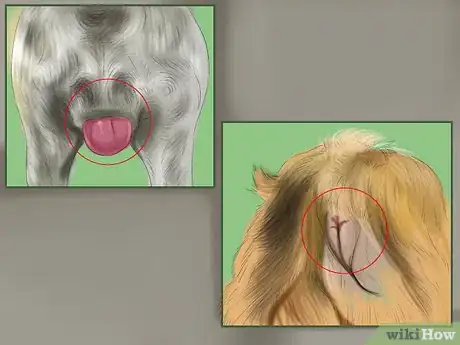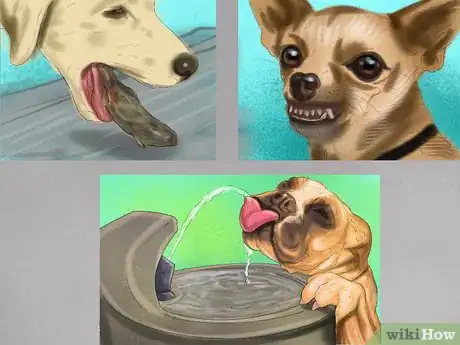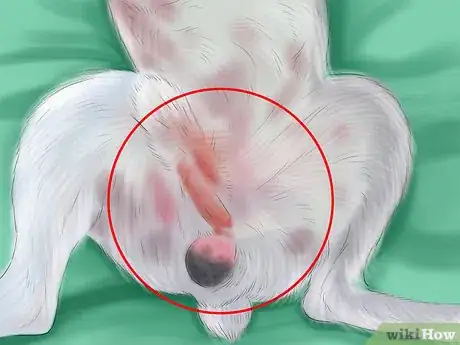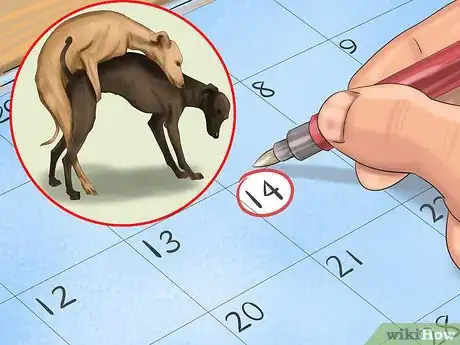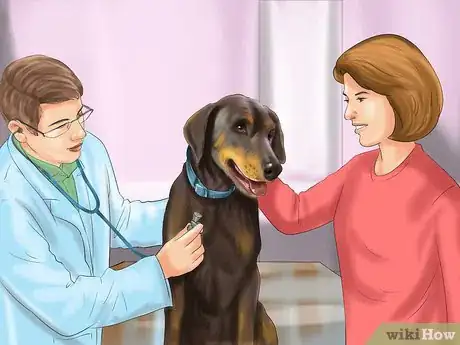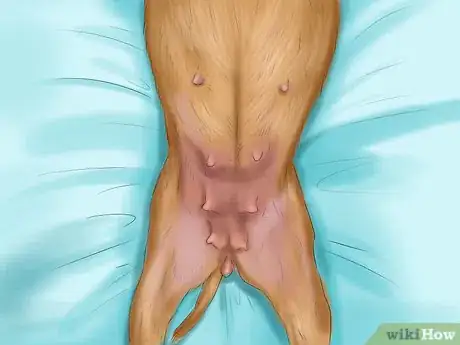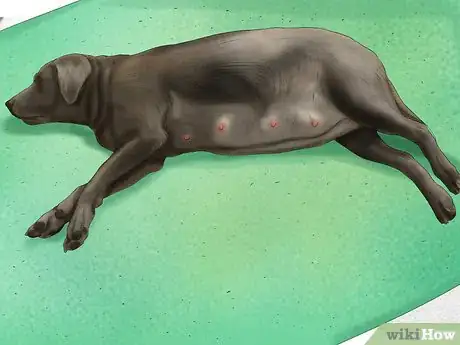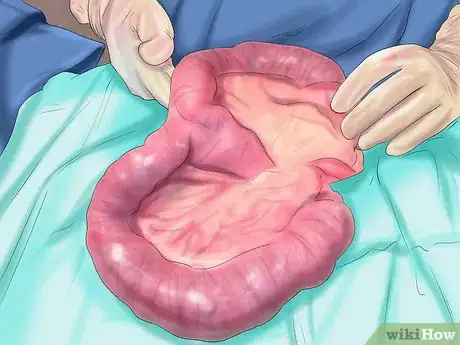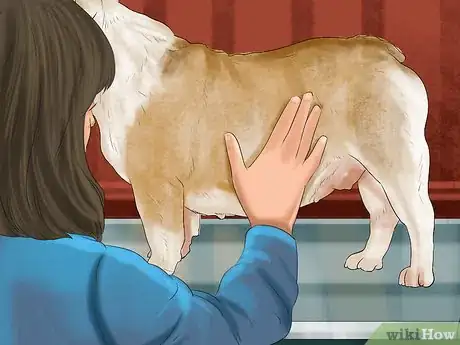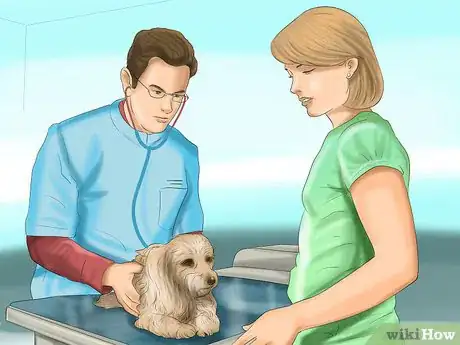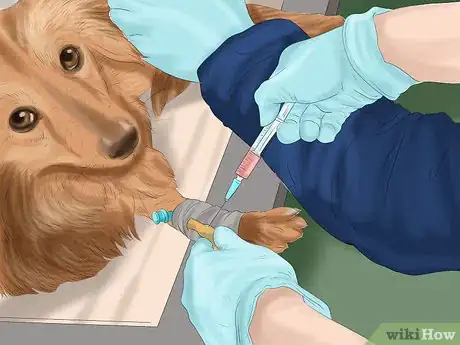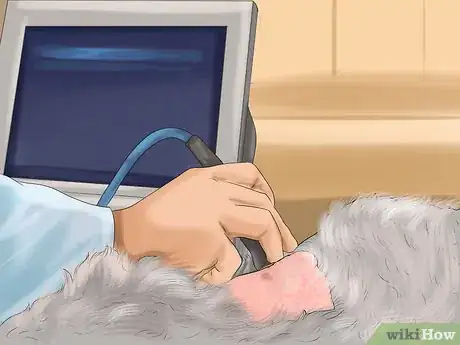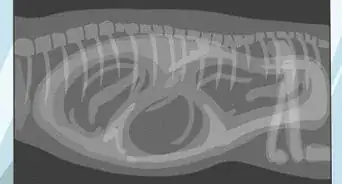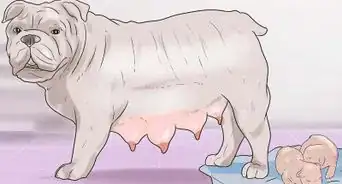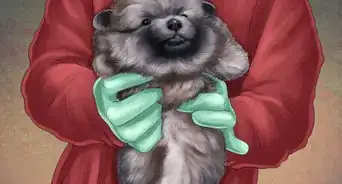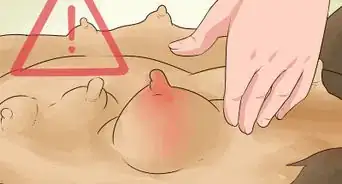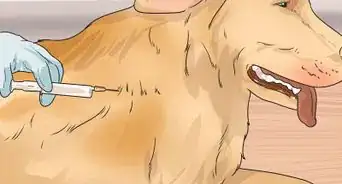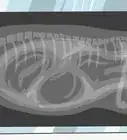This article was co-authored by Kateryna Zabashta. Kateryna Zabashta is a Dog Breeder and the Owner of Emma’s Frenchies in the San Francisco Bay Area. With over five years of experience, Kateryna specializes in dog nutrition, general care, and breeding French Bulldogs.
There are 8 references cited in this article, which can be found at the bottom of the page.
wikiHow marks an article as reader-approved once it receives enough positive feedback. This article has 11 testimonials from our readers, earning it our reader-approved status.
This article has been viewed 683,486 times.
If your female dog has mated with a male and neither of them has been neutered, then it's very possible she's pregnant. However, not every mating results in pregnancy, especially if the act happened at a time when your dog was not ovulating. So, if your female dog has been with a male, how can you tell if she is pregnant as a result? Here's how to detect when your dog might be in heat or pregnant.
Steps
Determining When Your Female Dog is in Heat
-
1Determine whether your dog is spayed. If you have had her since she was a puppy, then you will know if she has been neutered (had her womb removed) or not. However, if the dog came to you as an adult from a rescue center, then you might not know for sure. An entire (unneutered) female dog comes into heat twice a year, so if you have owned her for well over nine months and she has not been in heat, the likelihood of her being neutered increases.[1]
- While the duration of heat, or estrus, depends on the individual dog, it averages about 18 days. Dogs usually experience their first heat between six and 24 months of age.[2]
- See the next steps for signs of heat.
-
2Look for vaginal abnormalities. When your dog is in heat, you can observe changes in her vaginal area.
- An enlarged, swollen vulva: The swelling in the external area of her vagina often lasts around four weeks, from shortly before the heat starts, to just after it finishes.[3]
- Vaginal discharge: In the first seven to ten days of heat your dog may spot blood. It is helpful to put a white sheet in her bed and check for tell-tale signs of blood spotting. If your dog is fastidious, she may spend a lot of time washing her vulva, so the discharge may not be obvious. This discharge becomes lighter in the middle seven days of the season (which is when she is ovulating and most likely to get pregnant), and then returns for the final seven to ten days of the heat.[4]
Advertisement -
3Track behavioral changes. When your dog is in heat, she is experiencing a major hormonal event that usually causes a change in her behavior. How exactly she changes depends on her personality; it may mean that if she's usually placid, she'll become snappy and short-tempered, or if she's home-loving, she might suddenly get the desire to escape and go wandering.
- Aside from these changes, your dog should be otherwise well. If she lacks energy, loses her appetite, vomits, or drinks heavily, contact a vet for advice. Other womb conditions such as pyometra (pus in the womb) can mimic heat in rare cases, and may be life-threatening if left untreated.[5]
Considering Whether Pregnancy is a Possibility
-
1Recall whether it's possible she has mated with a dog. Obviously, it takes the participation of a male dog to get her pregnant. Think whether she has mated with a male dog, or whether it's possible that she escaped and found one to mate with.
-
2Determine whether that dog is castrated. Castrated or neutered male dogs can mate with a female but cannot produce sperm to impregnate her. Entire (unneutered) male dogs, however, can impregnate her. If possible, contact the dog's owners to confirm.
- The exception is a dog who was castrated in the recent past–less than four weeks before the mating. There is a theoretical risk that he could have sperm retained in his tubes, which he ejaculates during the mating. This risk is small, but cannot be completely ruled out.[6]
-
3Record the date she mated. This can give you vital information about whether it's possible she is pregnant. If the event happened three months ago, then she cannot be pregnant. This is because the average gestation (length of pregnancy) is 62 to 65 days (with a range from 57 to 72 days). If she had got pregnant then, by 90 days she would have given birth already.[7]
-
4Establish the dates your female dog was in heat. This can help your vet decide which is the best test to detect pregnancy. Pregnancy diagnosis methods depend on detecting hormonal changes, physical changes, or identifying embryos in the womb. Which test is the most likely to give a definitive answer depends on the number of days that have passed since mating.
- If a bitch was mated and the heat has not yet finished, it is too early to know if she is pregnant.[8]
Looking for Early Signs of Pregnancy
-
1Observe your dog for lethargy and other behavioral changes. Many owners remark that their bitch changes character during pregnancy: she seems sleepier, more lethargic, and starts to build nests.[9] However, these are also the signs associated with pseudopregnancy, or false pregnancy, where the bitch behaves as if she is pregnant when in fact she isn't. Some bitches with a false pregnancy even start producing milk, so enlarged mammary glands are not conclusive evidence of pregnancy.[10]
-
2Notice if your dog's nipples are growing. One of the more reliable signs of pregnancy is if a female dog "pinks up," which describes the enlargement of her nipples.[11] They become larger and often develop a rosy hue (hence the term "pinking").
- A pregnant bitch doesn't produce milk until near the end of gestation (or sometimes only after the puppies are born).
- Note that you'll still need to have your dog tested for pregnancy to confirm. Prominent pink nipples four or so weeks after mating are a highly suspect (but inconclusive) clue to pregnancy.[12]
-
3Look for an expanding waistline. As with pregnant women, an expanding center is a strong hint–but it should be interpreted with caution. In a healthy, fit bitch, her body silhouette may not show obvious changes until 50-55 days of pregnancy, when the womb is sufficiently enlarged to fill the tummy.
- Your dog does not need to take in extra calories until the final third of the pregnancy (after about 40 days). This means if you feed her extra early in the suspected pregnancy, she is likely to gain weight, but it will be fat and not necessarily puppies.[13]
-
4Familiarize yourself with the conditions that mimic pregnancy. If your dog is struggling during pregnancy, she needs help; however, there is also a distinct chance she is not pregnant, but has a condition mimicking pregnancy, including false pregnancy and pyometra. While a false pregnancy (usually caused by a hormonal imbalance after heat)[14] is not life-threatening, a pyometra definitely is. The latter is where the womb fills with pus, which causes blood poisoning, organ failure, and, if left untreated, death.
- The symptoms of pyometra can mimic pregnancy in that your dog's tummy may enlarge and she lacks energy. However, she is also likely to lose her appetite and have increased thirst. If these symptoms are present, call your vet at once.[15]
Testing for Pregnancy at the Veterinarian's
-
1Have an abdominal palpation to look for initial signs. During the abdominal palpation, the vet feels the bitch's tummy for the presence of puppies. The earliest date that this is likely to be successful is at least 21 days after mating. At this early stage the vet is feeling for an enlarged, thickened womb rather than puppies (which are like small blobs of jelly at this point).
- The best time for abdominal palpation is day 28. This is because the puppies are now big enough to make a "bump" in the womb, much like beads strung along a necklace.
- By day 35, the each puppy is surrounded by his own fluid capsule and the vet feels something akin to a fluid string of sausages.[16]
-
2Understand that abdominal palpitation can be problematic. Bear in mind that at 28 days each puppy swelling is a maximum of 25 mm (1 inch) in diameter, making it difficult to differentiate embryos in a womb from food in the gut or feces in the bowel. Furthermore, if your dog is tense and braces her belly wall, it can be impossible to feel anything worthwhile–the equivalent of trying to see through a window that has been painted over. Likewise, a single puppy can easily be missed, or mistaken for another structure such as the bladder, a kidney, or even feces in the bowel.
- Don't feel too frustrated with the veterinarian when she suggests a pregnancy test, as the abdominal palpitation can be inconclusive.[17]
-
3Do a blood test after day 28. The blood tests looks for high levels of the pregnancy hormone, progesterone. To be reliable, this test should be done after day 28. Before this it's possible to get false positive results, because the high levels might be a result of delayed decay of the hormone present during ovulation. However, after day 28, high levels of progesterone confirm pregnancy.[18]
-
4Have an ultrasound for early detection. Ultrasound scans are a popular way of confirming pregnancy, because in the hands of a skilled operator small changes in the womb can be detected as early as 18 days. The other advantage is that the technician may be able to give you an idea of how many puppies are in the litter, which is useful to know when it comes to the birth, or whelping.
- Placental units can be visible from day 18, and from day 28 the fetal heartbeats are visible.[19]
- Note that the ultrasound is a noninvasive procedure that is done while your dog is conscious. The ultrasound equipment sends a beam of high-frequency sound waves toward your dog's uterus, and the waves created "echoes" which are converted into images. This is considered a safe procedure. The fur on your dog's abdomen needs to be clipped so that the probe can make good contact with the skin.[20]
-
5Understand why radiography (x-ray) is not recommended. X-rays have largely been replaced by ultrasound for detecting pregnancy in dogs. Because they are only of use once the fetal skeleton is calcified, which happens after day 49, the diagnosis is made relatively late in the pregnancy. As for safety, while the risk of irradiating puppies in the womb is unlikely to do harm, it is likely your dog will need to be sedated, because current health and safety regulations for the operators of x-ray equipment mean they are not allowed to be in the room when the exposure is made. Since many bitches, especially when heavily pregnant, are not comfortable lying still and are likely to get up when left, the only other option is to sedate them.
- Sedating a pregnant bitch is best avoided because of the risk of a drop in blood pressure to puppies in the womb. For these reasons, the use of radiography for pregnancy diagnosis has gone out of vogue.[21]
Expert Q&A
-
QuestionWhat can cause a 14 month old puppy who is not pregnant to have swollen nipples?
 Pippa Elliott, MRCVSDr. Elliott, BVMS, MRCVS is a veterinarian with over 30 years of experience in veterinary surgery and companion animal practice. She graduated from the University of Glasgow in 1987 with a degree in veterinary medicine and surgery. She has worked at the same animal clinic in her hometown for over 20 years.
Pippa Elliott, MRCVSDr. Elliott, BVMS, MRCVS is a veterinarian with over 30 years of experience in veterinary surgery and companion animal practice. She graduated from the University of Glasgow in 1987 with a degree in veterinary medicine and surgery. She has worked at the same animal clinic in her hometown for over 20 years.
Veterinarian She might be having a phantom pregnancy. This is a hormonal event that happens to some female dogs, where their body incorrectly believes them to be pregnant. The body then undergoes changes associated with pregnancy, such as enlarged mammary glands and even milk production.
She might be having a phantom pregnancy. This is a hormonal event that happens to some female dogs, where their body incorrectly believes them to be pregnant. The body then undergoes changes associated with pregnancy, such as enlarged mammary glands and even milk production. -
QuestionMy rescue dog is neutered but is leaking milk. What should I do?
 Pippa Elliott, MRCVSDr. Elliott, BVMS, MRCVS is a veterinarian with over 30 years of experience in veterinary surgery and companion animal practice. She graduated from the University of Glasgow in 1987 with a degree in veterinary medicine and surgery. She has worked at the same animal clinic in her hometown for over 20 years.
Pippa Elliott, MRCVSDr. Elliott, BVMS, MRCVS is a veterinarian with over 30 years of experience in veterinary surgery and companion animal practice. She graduated from the University of Glasgow in 1987 with a degree in veterinary medicine and surgery. She has worked at the same animal clinic in her hometown for over 20 years.
Veterinarian If a female dog is neutered while she's having a false pregnancy, this can mean that she will produce milk permanently. The vet can either give a hormone injection, which will dry up the milk for 4-6 months (when another dose will need to be given), or there is a liquid medicine, which helps to dry up milk. Also, try not to let the dog mother cuddle toys, as this reinforces the milk production.
If a female dog is neutered while she's having a false pregnancy, this can mean that she will produce milk permanently. The vet can either give a hormone injection, which will dry up the milk for 4-6 months (when another dose will need to be given), or there is a liquid medicine, which helps to dry up milk. Also, try not to let the dog mother cuddle toys, as this reinforces the milk production. -
QuestionMy dog was mounted by another dog while she was in heat, but she is no longer bleeding. Is it still possible for her to get pregnant?
 Pippa Elliott, MRCVSDr. Elliott, BVMS, MRCVS is a veterinarian with over 30 years of experience in veterinary surgery and companion animal practice. She graduated from the University of Glasgow in 1987 with a degree in veterinary medicine and surgery. She has worked at the same animal clinic in her hometown for over 20 years.
Pippa Elliott, MRCVSDr. Elliott, BVMS, MRCVS is a veterinarian with over 30 years of experience in veterinary surgery and companion animal practice. She graduated from the University of Glasgow in 1987 with a degree in veterinary medicine and surgery. She has worked at the same animal clinic in her hometown for over 20 years.
Veterinarian Typically, a female dog ovulates sometime around day 9-14 of her estrus cycle. This is also when the bloody discharge appears to dry up, but then it returns for the final third of the heat. If it was during this middle part of the season when she mated, then pregnancy is likely. If, however, it was when she was coming to the end of her season (day 21 plus), then ovulation is less likely but not impossible, so the risk of pregnancy decreases.
Typically, a female dog ovulates sometime around day 9-14 of her estrus cycle. This is also when the bloody discharge appears to dry up, but then it returns for the final third of the heat. If it was during this middle part of the season when she mated, then pregnancy is likely. If, however, it was when she was coming to the end of her season (day 21 plus), then ovulation is less likely but not impossible, so the risk of pregnancy decreases.
References
- ↑ Reproduction in the Dog and Cat. I. J. Christiansen. Publisher: Bailliere Tindall.
- ↑ https://www.aspca.org/pet-care/dog-care/estrus-or-heat
- ↑ Kateryna Zabashta. Dog Breeder. Expert Interview. 19 March 2021.
- ↑ Reproduction in the Dog and Cat. I. J. Christiansen. Publisher: Bailliere Tindall.
- ↑ Reproduction in the Dog and Cat. I. J. Christiansen. Publisher: Bailliere Tindall.
- ↑ Small Animal Surgery. Fossum. Publisher: Mosby. 4th edition.
- ↑ Small Animal Surgery. Fossum. Publisher: Mosby. 4th edition.
- ↑ Reproduction in the Dog and Cat. I. J. Christiansen. Publisher: Bailliere Tindall.
- ↑ Kateryna Zabashta. Dog Breeder. Expert Interview. 19 March 2021.
- ↑ Reproduction in the Dog and Cat. I. J. Christiansen. Publisher: Bailliere Tindall.
- ↑ Kateryna Zabashta. Dog Breeder. Expert Interview. 19 March 2021.
- ↑ Reproduction in the Dog and Cat. I. J. Christiansen. Publisher: Bailliere Tindall.
- ↑ Reproduction in the Dog and Cat. I. J. Christiansen. Publisher: Bailliere Tindall.
- ↑ http://www.petmd.com/dog/conditions/reproductive/c_dg_false_pregnancy
- ↑ Small Animal Internal Medicine. Nelson and Couto. Publisher: Mosby.
- ↑ Reproduction in the Dog and Cat. I. J. Christiansen. Publisher: Bailliere Tindall.
- ↑ Reproduction in the Dog and Cat. I. J. Christiansen. Publisher: Bailliere Tindall.
- ↑ Reproduction in the Dog and Cat. I. J. Christiansen. Publisher: Bailliere Tindall.
- ↑ "The Use of Ultrasonography for Pregnancy Diagnosis in the Female dog." Shille & Gontarek. JAVMA 187, p 1021-1025.
- ↑ http://www.vcahospitals.com/main/pet-health-information/article/animal-health/ultrasound-examination-in-dogs/730
- ↑ Reproduction in the Dog and Cat. I. J. Christiansen. Publisher: Bailliere Tindall.
About This Article
Before you try to detect pregnancy in your female dog, figure out whether she has been spayed, has been in heat recently, or has been in contact with an unaltered male dog. If your dog has not been in heat or around a male dog in the last 2 months, she is probably not pregnant. However, if she has, look for signs of pregnancy, like her nipples becoming elongated and her belly growing. If you suspect your dog is pregnant, take her to the vet 28-30 days after the date you think she was impregnated to be sure. To learn how to tell if your dog is in heat, see our Veterinary's tips below!

